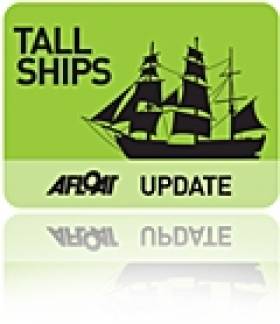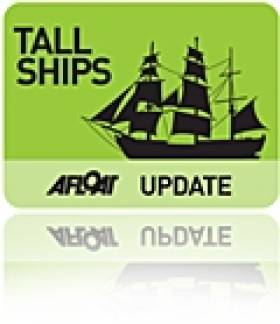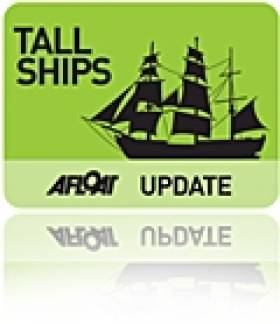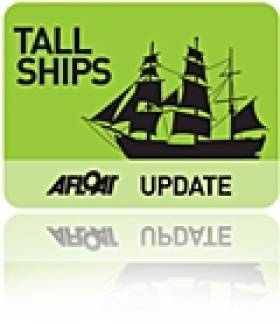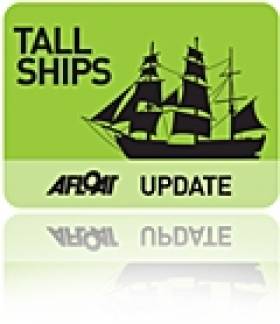Displaying items by tag: Tall Ships
#SailBessie – A fantastic opportunity to sail on a voyage to Drogheda to coincide with the maritime festival, is to see the 1904 built West Country trading ketch, Bessie Ellen set forth from Scotland on 7 June, writes Jehan Ashmore.
The 110 year-old lady, Bessie Ellen, will take in a seven-day voyage involving stunning scenery and famous landmarks along the way between the embarkation port in Oban and the mountains of Mull, Jura and Islay.
There may even be an en-route port of call to Northern Ireland or the Isle of Man, which could include a visit to a quirky port and an anchorage offshore to a secluded place you may not have heard of.
Bessie Ellen will then head for the second Drogheda Maritime Festival (13,14 and 15 June) as previously reported and where in total five tall ships are expected to gather.
If this whets your appetite to take a classic journey under sail and a chance to realise an ambition to step back in time on board a timber-built trading vessel then the Bessie Ellen is for you. She is only one of three surviving West Country ketches from more than 600 built as cargo-carrying vessels trading in the Irish Sea and northern Europe.
Interestingly, in recent years she has carried commercial wine-cargoes as she still holds a licence for present day small cargo-handling.
For example the French-owned Fair Wind Wine had chartered the vessel Bessie Ellen during the final Dublin Docklands Maritime Festival in 2010 for public wine-tasting! See below photo of the ketch during that festive occasion.
Also attending the what would become the final Dublin Docklands Development Authority (DDDA) organised festival was the French 'gabre' or trading vessel, Notre Dame de Romengol, a somewhat trawler-like looking craft.
So if you are interested in traditional sailing vessels offering sailing holiday voyages for 12 people and you have a zest for 'hands on' adventure why not become a crew member of Bessie Ellen.
West Country ketch Bessie Ellen during the final DDDA Docklands Maritime Festival in 2010. Photo Jehan Ashmore
With that in mind, the final leg will be from the mouth of the Boyne and heading upriver to be greeted at the Louth port as part of the Drogheda Maritime Festival. For further details and on prices, visit Classic Sailing's website HERE and above to hear her owner, Nikki Alford talk about her sailing holidays.
In addition to further updates on the Maritime Festival posted on Drogheda Port Company website.
#StenaTALLship – Stavros S. Niarchos a brig operating for Tall Ships Youth Trust departed Dublin Port this afternoon, having berthed at Sir John Rogersons Quay, writes Jehan Ashmore.
The 197ft brig which was the largest built in Britain for over a century was launched in 2000 from the Appledore Shipyard in North Devon.
She arrived to Dublin Port having made a passage on 30 March from Liverpool from where she spent a winter lay-up in the Canning Half Tide Dock.
As previously reported on Afloat.ie, she is one of more than 130 vessels managed by Clydebank based Northern Marine Management, a part of the Stena Group.
Over the years she has visited Irish ports to where she is not the only vessel in port to fly the Stena houseflag, notably at ferryports such as Dun Laoghaire Harbour with its fast-craft HSS Stena Explorer operating to Holyhead which is to resume service on 9 April.
In the meantime, tonight marks Stena Line's first ever direct Ireland-continental sailing as the former Celtic Link Ferries ro-pax, Celtic Horizon sets sail this evening at 21.30 on the Rosslare-Cherbourg route.
It is understood that the 940 passenger capacity ferry will be renamed next week the Stena Horizon.
Polaris/Pride of Galway Crew Reunion Next Week at DMYC
#tallshipsireland – Just over a week to go until the gathering of those involved in the Sail Training adventure that was the 25 metre ketch Polaris/Pride of Galway writes Fiacc OBrolchain. Trainees, crew, volunteers and skippers have been coming out of the woodwork as contacts have been renewed for what was, in retrospect, the golden age of Sail Training in Ireland.
Money was tight but there were more berths available to those interested with Asgard II, Polaris/Pride of Galway and the Yachtmaster training vessel Tir na nOg, not to mention the great work being done by Glenans.
There will be great retelling of voyages, Tall Ships events and the struggle to fund the programme on Thursday 3rd March
Ben Garvey will be along on the way to spread the ashes of his farther Brian who made the whole adventure possible with the huge effort put in by himself and his wife Sue.
Further information from Fiacc OBrolchain 087 6699729 [email protected]. April in the Dun Laoghaire Motor Yacht Club from 2000.174 words pic attached
Talk On Famous Irish Yacht 'Asgard' Ahead Of Centennial Sail-In
#Asgard - Round-the-world yachtsman Pat Murphy will give a special presentation later this month on what's perhaps the most famous yacht in Irish history, the Asgard.
All are welcome to the talk at 6.30pm on 31 March at Donaghmede Library in North Dublin, at which Murphy will recount the story of the gun-running vessel's 23-day secret voyage to land munitions for the Irish Volunteers in 1914. Early booking is advised - contact the library at 01 848 2833 or [email protected]
The talk precedes a centennial sail-in this summer to mark the pivotal date in Irish history when the original Asgard, owned and skippered by Erskine Childers, landed at Howth.
On Sunday 27 July 2014 - 100 years and a day after Childers' yacht delivered its cargo to the Irish Volunteers in their fight for home rule - a flotilla of boats comprising vessels from the period and more modern yachts will assemble outside Howth Harbour from 1.30pm.
The recreation of the landing is scheduled for 2.30pm, followed by the official presentation of the restored Asgard to the National Museum of Ireland, where it is currently on display at Collins Barracks; and a community picnic.
The day is being organised by a voluntary group, many of whom were involved in the rigging of the restored vessel, and will be celebrated with pier-side entertainment for all the family.
#tallship – The German Embassy in Dublin has announced the arrival of the GORCH FOCK, Tall Ship and Training Vessel of the German Navy. The vessel will pay a visit to Ireland from March 13th to 29th, 2014. It will be berthed at Cobh Cruise Terminal in the Port of Cork.
The crew will be happy to welcome the public for "open ship" events on Sunday, March 16th, and Sunday, March 23rd, from 2 – 5 p.m.
All are welcome, admission is free, no prior registration is required.
Get-Together Planned For Polaris/Pride Of Galway Sailors
#TallShips - For a number of years in the early 1990s, Ireland was the beneficiary of a gift of the use of a 25-metre ketch, Polaris, as a sail training vessel.
This programme was highly successful, and under the name Pride of Galway the ketch took part in various Tall Ships events, along with providing much needed sail training berth for young people in Ireland.
In early April, Ben Garvey - whose family owned Polaris - will visit Ireland and it is proposed that there will be a get-together in Dublin for all those who were involved in this exiting programme.
For further information contact Fiacc Ó Brolchain at [email protected].
Asgard II Award to be Presented at Tall Ships Ireland Prizegiving
#tallships – The perpetual 'Asgard II Award' for outstanding achievement are among a range of awards to be presented at the Tall Ships Ireland annual prizegiving this Saturday (January 25th) at the Mansion House on Dawson Street, Dublin 2.
There will also be Trainee and Watch-leader of the Year awards made plus details of the latest initiative to provide opportunity for 100 Dublin youths to sail on the Tall Ships in 2014.
In addition a schedule of Tall Ships visits to The Irish Sea and Dublin Port this Summer will be published.
Tall Ships for Drogheda Maritime Festival 2014
The Drogheda Maritime Festival will return in June 2014. Drogheda Borough Council and Drogheda Port Company have confirmed that the festival will go ahead next year after a successful first staging in 2013 when thousands of spectators viewed and visited the Tall Ships in Drogheda as well as enjoying a weekend of maritime-themed fun.
The intentions are that the Festival in June 2014 will become a flagship event for the town, attracting not only local people but creating a major tourism boost in Drogheda, highlighting the town's maritime culture and tradition.
In May of this year Drogheda Port Company opened its gates to the public for the first time as the Tall Ships made their way in full sail up along the Boyne into Drogheda Port. Spectators gathered not only along the Port but also at vantage points along the river, from Baltray to Mornington.
Current plans for the Drogheda Maritime Festival 2014 include the arrival of a range of tall ships, traditional gaffers and something very special indeed to be announced at a later date, in addition to a whole range of maritime quayside activities.
Speaking on the confirmation of the Drogheda Maritime Festival for 2014, Mayor Richie Culhane said "I am absolutely thrilled that there will be a Drogheda Maritime Festival next year. The arrival of the Tall Ships into Drogheda last May was a tremendous sight to behold.
"There was a fantastic atmosphere and thousands of people descended on the Port to take a look around the Ships while a number of our younger Drogheda citizens had the invaluable opportunity to travel over on a training ship. The Journey was an extremely eventful one and they all arrived back in to Port with a fantastic experience under their belts and an adventure to remember for the rest of their lives. Hopefully this is an experience that more of our young people can experience in the lead-up to next year's Festival."
Mary T Daly, Senior Executive Officer, Drogheda Borough Council, confirmed that the local authority will be lending major support to the Festival.
"The Maritime Festival and visit of the Tall Ships earlier this year was organised at very short notice but even so was a tremendous success and we in Drogheda Borough Council all saw the value in making such an event a primary feature in the town calendar.
"We have been working hard with our partners at Drogheda Port Company and are now in the process of booking five Tall Ships to arrive in Drogheda from June 13-15, 2014."
Nessa Lally, Corporate Administrator, Drogheda Port Company also expressed her delight at the return of the Drogheda Maritime Festival.
"It's a very busy working Port here in Drogheda so it was something completely different for us earlier this year to open up the Port and welcome the Tall Ships and be a part of the first Maritime
Festival in Drogheda.
"It was a relatively last minute event and was a very steep learning curve as we worked along with Drogheda Borough Council to make the Port safely accessible to the public but, without a doubt it was well worth it, and that's why we are more than happy to be involved with a bigger and better Drogheda Maritime Festival in June 2014."
"We are happy to announce that once again there will be a bursary programme in place supported by Drogheda Port, Sail Training Ireland and local industry to provide an opportunity for the young people of the area to sail on a tall ship from the UK to Drogheda. Details on this will be circulated at a later date. There will also be an opportunity to the public to avail of these unique voyages."
With the aim of making the Drogheda Maritime Festival the best possible event, with huge potential for the town , Drogheda Borough Council will be going to tender in the coming week for Event Management Services for the Drogheda Maritime Festival.
Tall Ship Astrid Is Cork Harbour Bound For Scrapping
#Astrid - The West Cork Times reports that the wreck of the tall ship Astrid is to be transported to Cork Harbour for scrapping.
Last week the Dutch training brig was recovered from her final resting place on rocks at the mouth of Kinsale Harbour using specialist lifting equipment brought over from the UK.
Though the hull of the 95-year-old ship was in remarkably good condition after she grounded close to the Sovereign Islands, it was decided early on that the severity of the damage she sustained would render her repair and restoration unlikely.
All 30 crew on board Astrid were brought to safety in a major rescue operation on 24 July last when the sail training vessel was blown onto rocks in high wind and quickly took on water.
In the weeks after the incident, items including the ship's bell and compass were recovered from the wreck by divers after they were initially thought to have been stolen in a night-time raid.
Astrid Salvage Operation Gets Coastguard Approval
#Astrid - The Irish Coast Guard has given approval for a salvage operation on the wreck of the tall ship Astrid off Kinsale, according to The Irish Times.
Afloat.ie reported more than a month ago on the major rescue operation involving the 42ft sail training vessel after it hit rocks inside the Sovereign Islands at Ballymacus Point and began taking on water.
All of the vessel's 30-strong crew were brought to safety in a rescue effort that involved four RNLI lifeboats.
Since the incident on 24 July, an exclusion zone was set up around the wreck site as an investigation as to how the Dutch brig came to run aground, and discussions were entered into as to the possibility of salvaging the vessel.
Earlier this month a number of items, including the ship's bell and compass, were recovered from the wreck by local divers after they were thought to have been stolen in the days after the incident.
Now finally an agreement have been reached between the Astrid's insurers and West Cork based salvage firm Atlantic Towage and Marine for salvage and removal of the 95-year-old tall ship.
Divers with the company have already completed a survey of the wreck and will submit a report to coastguard officials on Monday.
The start date and timescale have not yet been finalised, but it's expected the project would take up to two weeks, weather permitting, once under way.
The Irish Times has more on the story HERE.




























